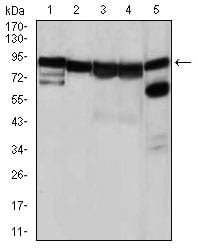
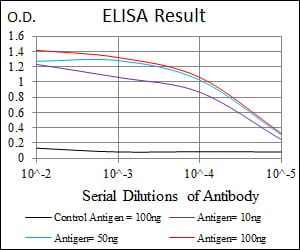
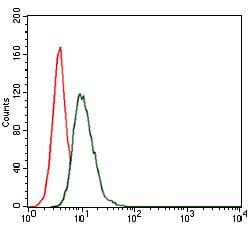
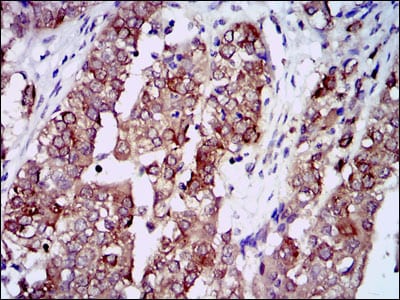
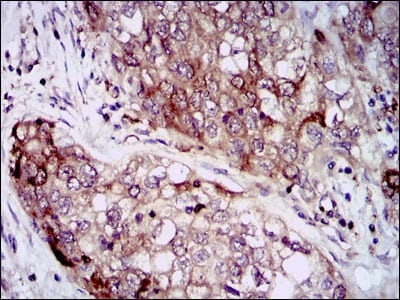
| WB | 1/500 - 1/2000 | Human,Mouse,Monkey |
| IF | 咨询技术 | Human,Mouse,Monkey |
| IHC | 1/200 - 1/1000 | Human,Mouse,Monkey |
| ICC | 技术咨询 | Human,Mouse,Monkey |
| FCM | 1/200 - 1/400 | Human,Mouse,Monkey |
| Elisa | 1/10000 | Human,Mouse,Monkey |
| Aliases | HSPN; LAP2; HSP86; HSPC1; HSPCA; Hsp89; Hsp90; HSP89A; HSP90A; HSP90N; HSPCAL1; HSPCAL4 |
| Entrez GeneID | 3320 |
| clone | 5G5 |
| WB Predicted band size | 90kDa |
| Host/Isotype | Mouse IgG1 |
| Antibody Type | Primary antibody |
| Storage | Store at 4°C short term. Aliquot and store at -20°C long term. Avoid freeze/thaw cycles. |
| Species Reactivity | Human,Mouse,Monkey |
| Immunogen | Purified recombinant fragment of human HSP90AA1 expressed in E. Coli. |
| Formulation | Purified antibody in PBS with 0.05% sodium azide |
+ +
1. **"HSP90AA1 promotes tumor metastasis by regulating the TLR4/NF-κB signaling pathway in colorectal cancer"**
- **作者**: Li W, et al.
- **摘要**: 该研究揭示了HSP90AA1通过激活TLR4/NF-κB通路促进结直肠癌转移的机制,并利用特异性抗体验证其在肿瘤组织中的高表达及其临床预后意义。
2. **"A monoclonal antibody targeting HSP90AA1 inhibits tumor growth in HER2-positive breast cancer models"**
- **作者**: Smith SJ, et al.
- **摘要**: 研究开发了一种靶向HSP90AA1的单克隆抗体,证明其可通过降解HER2蛋白抑制乳腺癌细胞增殖和移植瘤生长,为靶向治疗提供新策略。
3. **"Structural basis of HSP90AA1 recognition by a pan-HSP90 inhibitor PU-H71"**
- **作者**: Immormino RM, et al.
- **摘要**: 通过冷冻电镜和抗体共结晶技术解析了HSP90AA1与抑制剂PU-H71的复合物结构,揭示了其ATP结合域的关键相互作用,为抗体药物设计提供结构基础。
4. **"HSP90AA1 as a serum biomarker for early detection of hepatocellular carcinoma"**
- **作者**: Zhang Y, et al.
- **摘要**: 研究发现肝癌患者血清中HSP90AA1水平显著升高,利用ELISA和Western Blot(基于特异性抗体)验证其作为早期诊断标志物的潜力。
The HSP90AA1 antibody targets the heat shock protein 90 alpha family class A member 1 (HSP90AA1), a molecular chaperone critical for maintaining cellular homeostasis under stress. HSP90AA1. part of the HSP90 family, facilitates the folding, stabilization, and activation of client proteins, including kinases, transcription factors, and steroid hormone receptors. It plays a pivotal role in stress response, cell signaling, and cancer progression, as many client proteins are oncogenic. Dysregulation of HSP90AA1 is linked to tumorigenesis, neurodegenerative diseases, and inflammatory conditions, making it a therapeutic target.
HSP90AA1 antibodies are essential tools for studying its expression, localization, and interactions. They are widely used in techniques like Western blotting, immunohistochemistry (IHC), immunoprecipitation (IP), and immunofluorescence (IF) to investigate HSP90AA1's role in disease mechanisms. Specific antibodies can distinguish between HSP90 isoforms (e.g., HSP90α vs. HSP90β) or detect post-translational modifications (e.g., phosphorylation, acetylation) that regulate its activity. Researchers also utilize these antibodies to evaluate the efficacy of HSP90 inhibitors in preclinical cancer models. Monoclonal antibodies, such as those targeting the N-terminal ATP-binding domain, are commonly employed for functional studies, while polyclonal antibodies offer broader epitope recognition. Validating antibody specificity using knockout controls is crucial due to high homology among HSP90 family members. Overall, HSP90AA1 antibodies are indispensable for advancing research in molecular chaperone biology and therapeutic development.
×